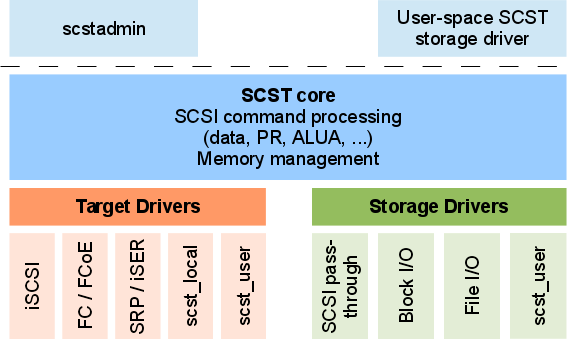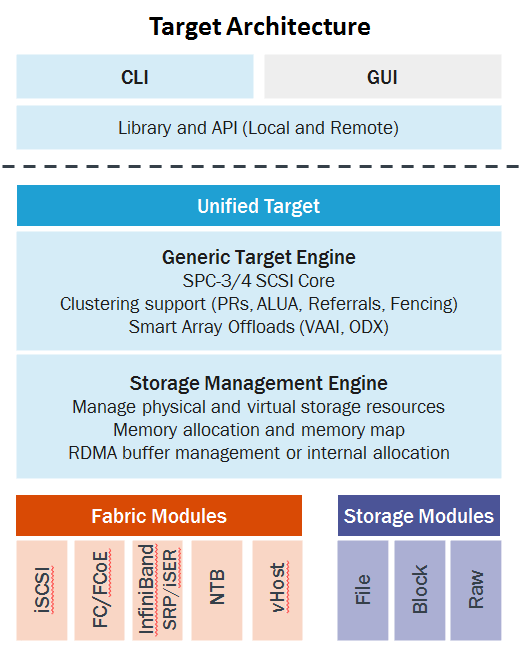|
ISCSI Extensions For RDMA
The iSCSI Extensions for RDMA (iSER) is a computer network protocol that extends the Internet Small Computer System Interface (iSCSI) protocol to use Remote Direct Memory Access ( RDMA). RDMA is provided by either the Transmission Control Protocol (TCP) with RDMA services (iWARP) that uses existing Ethernet setup and therefore no need of huge hardware investment, RoCE ( RDMA over Converged Ethernet) that does not need the TCP layer and therefore provides lower latency, or InfiniBand. It permits data to be transferred directly into and out of SCSI computer memory buffers (which connects computers to storage devices) without intermediate data copies and without much CPU intervention. History An RDMA consortium was announced on May 31, 2002, with a goal of product implementations by 2003. The consortium released their proposal in July, 2003. The protocol specifications were published as drafts in September 2004 in the Internet Engineering Task Force and issued as RFCs in October 2007 ... [...More Info...] [...Related Items...] OR: [Wikipedia] [Google] [Baidu] |
Communications Protocol
A communication protocol is a system of rules that allows two or more entities of a communications system to transmit information via any kind of variation of a physical quantity. The protocol defines the rules, syntax, semantics and synchronization of communication and possible error recovery methods. Protocols may be implemented by hardware, software, or a combination of both. Communicating systems use well-defined formats for exchanging various messages. Each message has an exact meaning intended to elicit a response from a range of possible responses pre-determined for that particular situation. The specified behavior is typically independent of how it is to be implemented. Communication protocols have to be agreed upon by the parties involved. To reach an agreement, a protocol may be developed into a technical standard. A programming language describes the same for computations, so there is a close analogy between protocols and programming languages: ''protocols ar ... [...More Info...] [...Related Items...] OR: [Wikipedia] [Google] [Baidu] |
OpenFabrics Alliance
The OpenFabrics Alliance is a non-profit organization that promotes remote direct memory access (RDMA) switched fabric technologies for server and storage connectivity. These high-speed data-transport technologies are used in high-performance computing facilities, in research and various industries. The OpenFabrics Alliance aims to develop open-source software that supports the three major RDMA fabric technologies: InfiniBand, RDMA over Converged Ethernet (RoCE) and iWARP. The software includes two packages, one that runs on Linux and FreeBSD and one that runs on Microsoft Windows. The alliance worked with two large Linux distributors—SUSE and Red Hat—as well as Microsoft on compatibility with their operating systems. History Founded in June 2004 as the OpenIB Alliance, the organization originally developed an InfiniBand software stack for Linux. Initial funding for the Alliance was provided by the United States Department of Energy. The alliance released the first ver ... [...More Info...] [...Related Items...] OR: [Wikipedia] [Google] [Baidu] |
SCSI RDMA Protocol
In computing the SCSI RDMA Protocol (SRP) is a protocol that allows one computer to access SCSI devices attached to another computer via remote direct memory access (RDMA).ANSI T10 SRPr16a, www.t10.org ANSI T10 SRPr16a, web.archive.org /ref> The SRP protocol is also known as the SCSI Remote Protocol. The use of RDMA makes higher throughput and lower latency possible than what is generally available through e.g. the TCP/IP communication protocol. Though the SRP protocol has been designed to use RDMA networks efficiently, it is also possible to implement the SRP protocol over networks that do not support RDMA. |
SCST
SCST is a GPL licensed SCSI target software stack. The design goals of this software stack are high performance, high reliability, strict conformance to existing SCSI standards, being easy to extend and easy to use. SCST does not only support multiple SCSI protocols (iSCSI, FC, SRP, ...) but also supports multiple local storage interfaces (SCSI pass-through, block I/O and file I/O) and also storage drivers implemented in user-space via the scst_user driver. In order to reach maximum performance SCST has been implemented as a set of kernel drivers. SCST is often combined with RAID, data deduplication and/or high-availability cluster software to augment its functionality. The SCST software stack is the basis software of many SAN systems. Several world records have been set with SAN systems based on SCST. SCST competes with LIO Target for the same purpose of providing a generic SCSI target module inside the Linux kernel. For the narrower purpose providing a Linux iSCSI target ... [...More Info...] [...Related Items...] OR: [Wikipedia] [Google] [Baidu] |
LIO Target
In computing, Linux-IO (LIO) Target is an open-source implementation of the SCSI target that has become the standard one included in the Linux kernel. Internally, LIO does not initiate sessions, but instead provides one or more Logical Unit Numbers (LUNs), waits for SCSI commands from a SCSI initiator, and performs required input/output data transfers. LIO supports common storage fabrics, including FCoE, Fibre Channel, IEEE 1394, iSCSI, iSCSI Extensions for RDMA (iSER), SCSI RDMA Protocol (SRP) and USB. It is included in most Linux distributions; native support for LIO in QEMU/ KVM, libvirt, and OpenStack makes LIO also a storage option for cloud deployments. LIO is maintained by Datera, Inc., a Silicon Valley vendor of storage systems and software. On January 15, 2011, LIO SCSI target engine was merged into the Linux kernel mainline, in kernel version 2.6.38, which was released on March 14, 2011. Additional fabric modules have been merged into subsequent Linux releases. ... [...More Info...] [...Related Items...] OR: [Wikipedia] [Google] [Baidu] |
Open-source Software
Open-source software (OSS) is computer software that is released under a license in which the copyright holder grants users the rights to use, study, change, and distribute the software and its source code to anyone and for any purpose. Open-source software may be developed in a collaborative public manner. Open-source software is a prominent example of open collaboration, meaning any capable user is able to participate online in development, making the number of possible contributors indefinite. The ability to examine the code facilitates public trust in the software. Open-source software development can bring in diverse perspectives beyond those of a single company. A 2008 report by the Standish Group stated that adoption of open-source software models has resulted in savings of about $60 billion per year for consumers. Open source code can be used for studying and allows capable end users to adapt software to their personal needs in a similar way user scripts a ... [...More Info...] [...Related Items...] OR: [Wikipedia] [Google] [Baidu] |
Request For Comments
A Request for Comments (RFC) is a publication in a series from the principal technical development and standards-setting bodies for the Internet, most prominently the Internet Engineering Task Force (IETF). An RFC is authored by individuals or groups of engineers and computer scientists in the form of a memorandum describing methods, behaviors, research, or innovations applicable to the working of the Internet and Internet-connected systems. It is submitted either for peer review or to convey new concepts, information, or, occasionally, engineering humor. The IETF adopts some of the proposals published as RFCs as Internet Standards. However, many RFCs are informational or experimental in nature and are not standards. The RFC system was invented by Steve Crocker in 1969 to help record unofficial notes on the development of ARPANET. RFCs have since become official documents of Internet specifications, communications protocols, procedures, and events. According to Crocker, the doc ... [...More Info...] [...Related Items...] OR: [Wikipedia] [Google] [Baidu] |
ISCSI
Internet Small Computer Systems Interface or iSCSI ( ) is an Internet Protocol-based storage networking standard for linking data storage facilities. iSCSI provides block-level access to storage devices by carrying SCSI commands over a TCP/IP network. iSCSI facilitates data transfers over intranets and to manage storage over long distances. It can be used to transmit data over local area networks (LANs), wide area networks (WANs), or the Internet and can enable location-independent data storage and retrieval. The protocol allows clients (called ''initiators'') to send SCSI commands ( ''CDBs'') to storage devices (''targets'') on remote servers. It is a storage area network (SAN) protocol, allowing organizations to consolidate storage into storage arrays while providing clients (such as database and web servers) with the illusion of locally attached SCSI disks. It mainly competes with Fibre Channel, but unlike traditional Fibre Channel which usually requires dedicated cabling, ... [...More Info...] [...Related Items...] OR: [Wikipedia] [Google] [Baidu] |
Internet Engineering Task Force
The Internet Engineering Task Force (IETF) is a standards organization for the Internet and is responsible for the technical standards that make up the Internet protocol suite (TCP/IP). It has no formal membership roster or requirements and all its participants are volunteers. Their work is usually funded by employers or other sponsors. The IETF was initially supported by the federal government of the United States but since 1993 has operated under the auspices of the Internet Society, an international non-profit organization. Organization The IETF is organized into a large number of working groups and birds of a feather informal discussion groups, each dealing with a specific topic. The IETF operates in a bottom-up task creation mode, largely driven by these working groups. Each working group has an appointed chairperson (or sometimes several co-chairs); a charter that describes its focus; and what it is expected to produce, and when. It is open to all who want to partic ... [...More Info...] [...Related Items...] OR: [Wikipedia] [Google] [Baidu] |
SCSI
Small Computer System Interface (SCSI, ) is a set of standards for physically connecting and transferring data between computers and peripheral devices. The SCSI standards define commands, protocols, electrical, optical and logical interfaces. The SCSI standard defines command sets for specific peripheral device types; the presence of "unknown" as one of these types means that in theory it can be used as an interface to almost any device, but the standard is highly pragmatic and addressed toward commercial requirements. The initial Parallel SCSI was most commonly used for hard disk drives and tape drives, but it can connect a wide range of other devices, including scanners and CD drives, although not all controllers can handle all devices. The ancestral SCSI standard, X3.131-1986, generally referred to as SCSI-1, was published by the X3T9 technical committee of the American National Standards Institute (ANSI) in 1986. SCSI-2 was published in August 1990 as X3.T9.2/86-109 ... [...More Info...] [...Related Items...] OR: [Wikipedia] [Google] [Baidu] |



